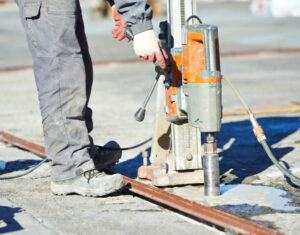
There are a few types of concrete scanning and imaging that people use, and knowing how all of them work will help you determine which method you will want to use on your worksite.
Anyone who has to work with concrete understands the value of concrete scanning. You need to be sure that drilling, coring, and cutting are all safe before you begin a project, and scanning the site is what tells you whether or not the coast is clear. If you don’t scan a site, you run the risk of striking all sorts of underground hazards, such as post-tension cables and electrical conduits.
There are a few types of concrete scanning and imaging that people use, and knowing how all of them work will help you determine which method you will want to use on your worksite.
Ground Penetrating Radar (GPR)
Ground-penetrating radar is pretty widely known in the industries of demolition and construction. It’s among the most commonplace tools used to detect utilities that are concealed underground. For GPR, two antennas are used. There’s a transmitter and a receiver. Using this method, electromagnetic pulses get sent underground. Waves then get reflected to the surface, and these reflected waves help determine what’s underground and where utilities are located.
GPR is one of the safest, quickest, and most cost-effective methods available, and it can be used for many purposes. Such purposes for GPR include:
- Measuring thickness of concrete
- Finding safe spots for drilling, coring, and cutting
- Locating rebar and post-tension cables, as well as determining how deep they are
- Detecting possible defects and voids inside of concrete slabs
Ultrasonic Tomography
Ultrasonic tomography is used mainly to determine concrete slabs’ integrity, find flaws in them, and measure their thickness. It accomplishes this task by putting stress waves through the right materials. A transmitter helps send pulses into various test materials. Then, these pulses will be reflected back either by interfaces or by flaws in the structure. A receiving transducer then keeps track of the reflected waves and the impulses that were emitted. Uses for ultrasonic tomography include:
- Finding cracks in concrete
- Finding rebar
- Noticing defects inside of concrete structures
Radiography Using X-Ray
X-ray scanning is older than the other methods we have mentioned. However, it is still effective, and it can even rival the precision of GPR in some situations. The main drawback that comes with X-ray scanning is that you need to be capable of accessing both sides of whatever concrete structure you want to scan. This makes X-rays a less flexible scanning option, not to mention the concerns with radiation emissions, which can be dangerous to people in the surrounding area, including the operators.
Concrete Visions Will Get The Job Done Right
Concrete Visions has been working with clients for over 25 years. Our G&M Services installers are certified with the industry’s major firestop product manufacturers. As part of our firestop service, we can assess abnormal field conditions and, with the manufacturer’s technical support assistance, provide engineering judgments in a timely fashion to comply with contract specifications. Our Field Mechanics undergo ongoing training, including mandatory monthly safety meetings, weekly Toolbox Talks where safety and equipment information is shred, and trainings on safe work standards and safety best practices.
